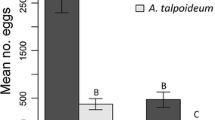Summary
Non-random mating by size (NRMS) plays a central role in the study of sexual selection and the evolution of mating systems. Theory suggests that NRMS should be influenced by conflicting demands (e.g., predation risk, hunger); few experimental studies, however, have addressed these effects. We used a factorial experiment to examine the influence of predatory green sunfish and food deprivation on NRMS in male and female stream water striders, Aquarius remigis. As predicted by theory, food deprivation decreased the large-male mating advantage. The influence of predation risk, however, went against existing theory; that is, risk increased the large male mating advantage. The degree of large-male mating advantage was negatively related to a measure of the rate of male harassment of females. A behavioral mechanism that can explain these patterns emphasizes the contrasting effects of different competing demands on male harassment rates, female resistance and the role of male size in overcoming female resistance. Females usually resist male mating attempts. Successful mating occurs when males overcome female resistance. If harassment rates (of females by males) are low, larger males have a mating advantage over smaller males perhaps because females resist heavily and thus only larger males can overcome female resistance. If, however, male harassment rates are very high, female resistance might be swamped; mating should then be more random with respect to male size. Food deprivation increases gerrid activity and thus increases harassment rates which should then reduce NRMS. In contrast, risk decreases gerrid activity, thus decreasing harassment rates and increasing NRMS. Females did not show significant NRMS. Females did, however, show a pattern of change in NRMS that is consistent with male choice for larger females.
Similar content being viewed by others
References
Arnqvist G (1989) Multiple mating in a water strider: mutual benefits or intersexual conflict. Anim Behav 38:749–756
Bateson P (1983) Mate choice. Cambridge Univ Press, Cambridge
Clark SJ (1987) Prolonged copulation in the water strider Gerris remigis and a model of the evolution of sperm competition avoidance mechanisms. PhD thesis, Rockefeller Univ
Clark SJ (1988) The effects of operational sex ratio and food deprivation on copulation duration in the water strider (Gerris remigis Say). Behav Ecol Sociobiol 23:317–322
Clutton-Brock TH (1988) Reproductive success: studies of individual variation in contrasting breeding systems. Univ Chicago Press, Chicago
Cooper SD (1984) The effects of trout on water striders in stream pools. Oecologia 63:376–379
Crowley PH, Travers SE, Linton MC, Cohn SL, Sih A, Sargent RC (1991) Mate density, predation risk, and the seasonal sequence of mate choices: a dynamic game. Am Nat 137:567–596
Darwin C (1871) The descent of man, and selection in relation to sex, 2nd edn. Burt, New York
Endler J (1987) Predation, light intensity and courtship behaviour in Poecilia reticulata. Anim Behav 35:1376–1385
Fairbairn DJ (1985) Comparative ecology of Gerris remigis (Hemiptera: Gerridac) in two habitats: a paradox of habitat choice. Can J Zool 63:2594–2603
Fairbairn DJ (1986) Does alary polymorphism imply dispersal polymorphism in the waterstrider, Gerris remigis? Ecol Entomol 11:355–368
Fairbairn DJ (1988) Sexual selection for homogamy in the Gerridae: an extension of Ridley's comparative approach. Evolution 42:1212–1222
Halliday TR (1987) Physiological constraints on sexual selection. In: Bradbury JW, Andersson MB (eds) Sexual selection: testing the alternatives. Wiley, New York, pp 247–264
Janetos AC (1980) Strategies of female choice: a theoretical analysis. Behav Ecol Sociobiol 7:107–112
Krupa JJ, Leopold WR, Sih A (1990) Behavioural shifts by female water striders in response to single males. Behaviour 115:247–253
Lima SL, Dill LM (1990) Behavioral decisions under the risk of predation: a review and prospectus. Can J Zool 68:619–640
Magnhagen C (1991) Predation risk as a cost of reproduction. Trends Ecol Evol 6:183–186
Parker GA (1983) Mate quality and mating decisions. In: Bateson P (ed) Mate choice. Cambridge Univ Press, Cambridge, pp 141–166
Partridge L, Endler JA (1987) Life history constraints on sexual selection. In: Bradbury JW, Andersson MB (eds) Sexual selection: testing the alternatives. Wiley, New York, pp 265–277
Real L (1990) Search theory and mate choice. I. Models of single-sex discrimination. Am Nat 136:376–404
Ridley M (1983) The explanation of organic diversity. Clarendon, Oxford
Robinson BW, Doyle RW (1985) Trade-off between male reproduction (amplexus) and growth in the amphipod Gammarus lawrencianus. Biol Bull 168:482–488
Rowe L (1992) Convenience polyandry in a waterstrider: foraging conflicts and female control of copulation frequency and guarding duration. Anim Behav, in press
Rubenstein DJ (1984) Resource acquisition and alternative mating strategies in water striders. Am Zool 24:345–353
Rubenstein DJ (1988) Sperm competition in the water strider, Gerris remigis. Anim Behav 38:631–636
Ryan M (1985) The Tungara frog: a study in sexual selection and communication. Univ Chi Press, Chicago
Sih A (1987) Predators and prey lifestyles: an evolutionary and ecological overview. In: Kerfoot WC, Sih A (ed) Predation: direct and indirect impacts on aquatic communities. Univ Press New England, Hanover, pp 203–224
Sih A (1988) The effects of predators on habitat use, activity and mating behaviour of a semi-aquatic bug. Anim Behav 36:1846–1848
Sih A, Krupa JJ, Travers SE (1990) An experimental study on the effects of predation risk, and feeding regime on the mating behavior of the water strider, Gerris remigis. Am Nat 135:284–290
Thornhill R, Alcock J (1983) The evolution of insect mating systems. Harvard Univ Press, Cambridge
Travers SE, Sih A (1991) The influence of starvation and predators on the mating behavior of a semi-aquatic insect. Ecology 72:2123–2136
Tuttle MD, Ryan MJ (1982) The role of synchronized calling, ambient light, and ambient noise in anti-bat-predator behavior of a treefrog. Behav Ecol Sociobiol 11:125–131
Wilcox RS (1984) Male copulatory guarding enhances female foraging in a water strider. Behav Ecol Sociobiol 15:171–174
Author information
Authors and Affiliations
Additional information
Correspondence to: A. Sih
Rights and permissions
About this article
Cite this article
Sih, A., Krupa, J.J. Predation risk, food deprivation and non-random mating by size in the stream water strider, Aquarius remigis . Behav Ecol Sociobiol 31, 51–56 (1992). https://doi.org/10.1007/BF00167815
Received:
Accepted:
Issue Date:
DOI: https://doi.org/10.1007/BF00167815




